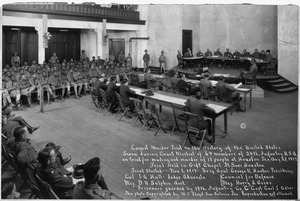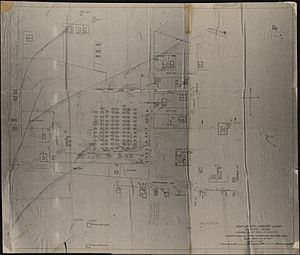Houston riot of 1917 facts for kids
Quick facts for kids Houston riot of 1917 |
|||
|---|---|---|---|

Court Martial of 64 members of the 24th Infantry. Trial started November 1, 1917, Fort Sam Houston
|
|||
| Date | 23 August 1917 | ||
| Location | |||
| Parties to the civil conflict | |||
|
|||
| Lead figures | |||
|
|||
| Arrests, etc. | |||
|
|||
| 19 soldiers executed after court-martials and other proceedings | |||
The Houston Riot of 1917 was a serious event that happened on August 23, 1917, in Houston, Texas. It involved 156 soldiers from the all-black 24th Infantry Regiment of the United States Army. This event is sometimes called the Camp Logan Mutiny.
Contents
What Caused the Houston Riot?
The soldiers of the 24th Infantry Regiment were stationed at Camp Logan in Houston. At this time, there was a lot of tension between the all-white Houston Police Department and the local black community. Black soldiers also faced unfair treatment from some police officers.
On August 23, 1917, some police officers arrested and mistreated black soldiers. This made many of their fellow soldiers very upset. They decided to protest and marched into Houston.
The Uprising in Houston
During the protest, the soldiers opened fire. Sadly, eleven civilians and five policemen were killed. Four soldiers also died during the event. Sergeant Vida Henry, who led the protesting soldiers, also died.
After the riot, the soldiers involved faced serious military trials called courts-martial. Nineteen soldiers were put to death, and 41 others were sent to prison for life.
After the Riot: Martial Law
The morning after the riot, Houston was put under martial law. This meant the military took control of the city. The remaining soldiers at Camp Logan were disarmed. A search was done in the San Felipe district to find any soldiers who were hiding.
Soldiers who were in local jails were given to the Army. The 3rd Battalion of the 24th Infantry was sent by train back to New Mexico.
The Military Trials Begin
During the first military trial, called a court-martial, almost 200 people gave their statements. This trial lasted for 22 days. The records of what everyone said filled more than 2,000 pages.
It was dark and rainy during the riot, which made it hard for many witnesses to clearly see who was involved. Some historians have also questioned if all the witness statements were completely true. This is because some witnesses who said they were involved were given special deals or promises of lighter sentences.
More Trials and Sentences
After the first trial, more trials took place. In a second trial, called the "Washington" case, fifteen men were tried. Five of them were sentenced to death.
A third trial, known as the "Tillman" case, involved 40 more soldiers. Twenty-three of these soldiers were found guilty. Eleven of them were sentenced to death, and the other twelve were sentenced to life in prison.
Later Developments and Recognition
Over the years, some of the soldiers who were imprisoned were released.
On December 14, 1924, four of the soldiers were released on parole. This meant they could leave prison but had to follow certain rules. Thirty-four soldiers remained in prison at Fort Leavenworth.
Later, on March 8, 1927, President Calvin Coolidge reduced the sentences for the last 20 imprisoned soldiers. This made them eligible for parole within one year.
In 1937, the remains of the 13 soldiers who had been put to death were moved from their unmarked graves. They were reburied with military headstones in Fort Sam Houston National Cemetery. This gave them proper recognition for their service.
As of February 2022, the Pentagon is looking into a request to pardon all those who were found guilty in the riot.
Camp Logan Today
The area where Camp Logan was once located is now a large public space called Memorial Park. It is a popular park in Houston and is bordered by highways I-10 and I-610.




